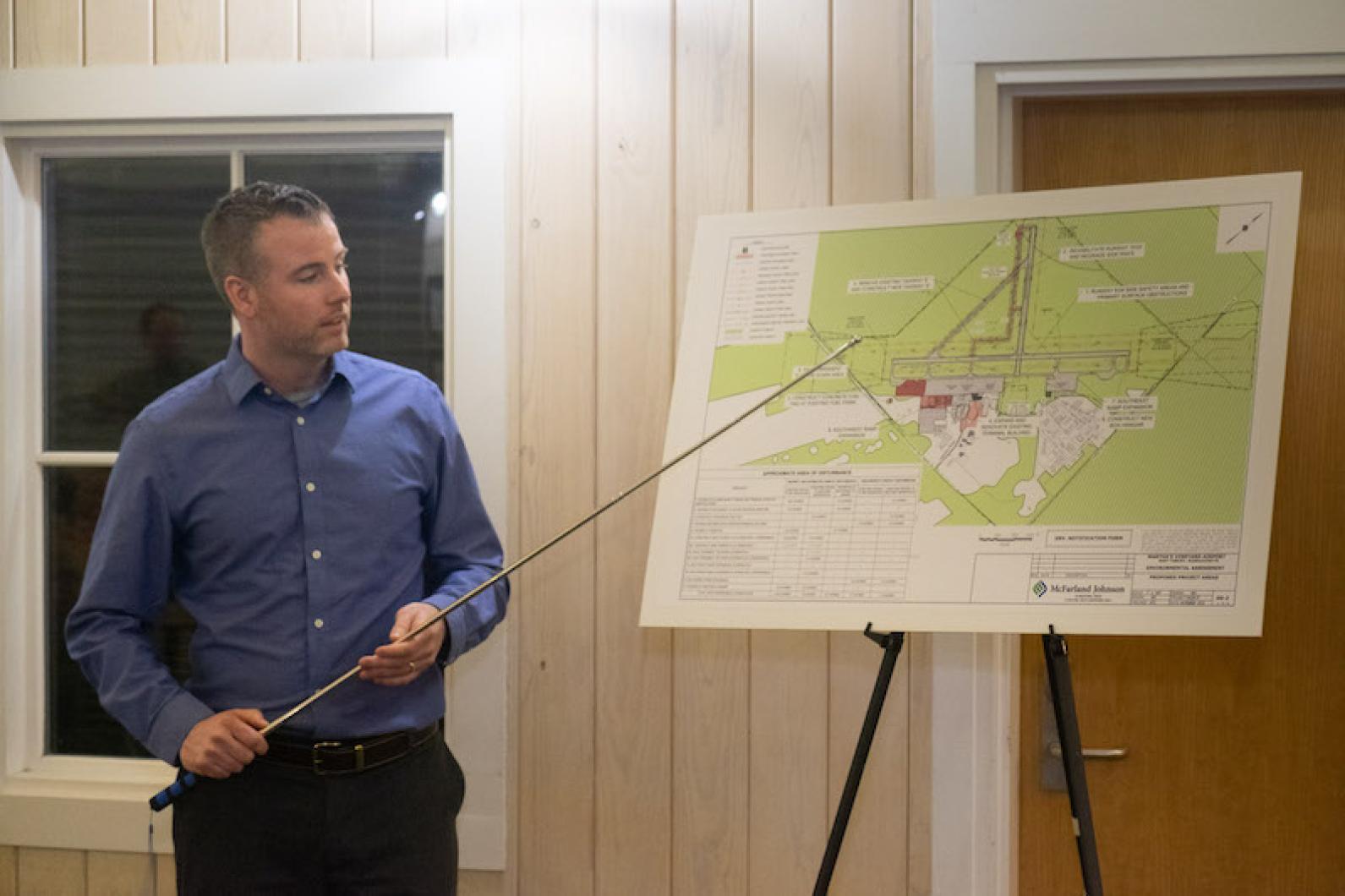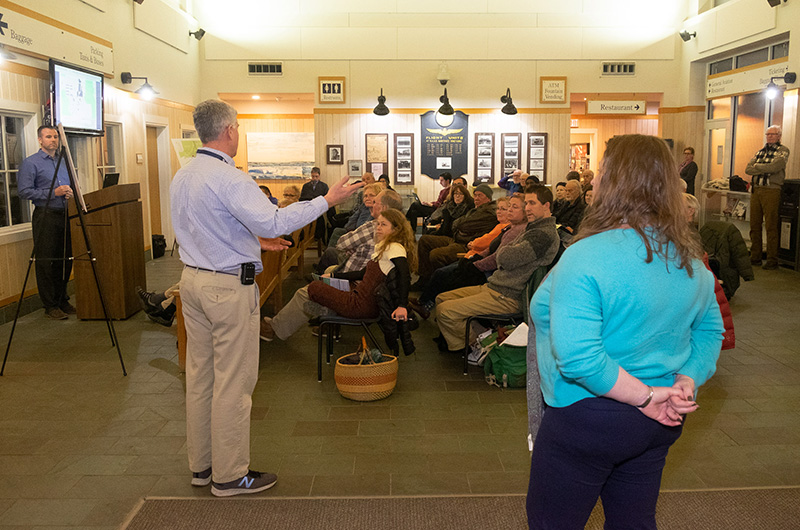An early-stage plan to significantly expand the terminal and parking facilities at the Martha’s Vineyard Airport saw backlash from Island residents at a public hearing Thursday evening. Among other things, the hearing saw detailed questions about both the need for and environmental impacts of more than doubling the size of the airport terminal and adding another 550 parking spaces.
“New, bigger, better isn’t always better,” Chilmark resident Paul Iantosca told airport leaders and state environmental officials.
The hearing, rescheduled from mid-January, is one of the first steps in a lengthy environmental approval process for nine projects outlined in an Environmental Notification Form (ENF) filed by the airport with the office of the Massachusetts Environmental Policy Act (MEPA) last month. The projects include renovating runways, expanding the terminal by adding more than 10,000 square feet, adding a right turn lane exiting the airport road and building new hangars for corporate aircraft.
In August airport managers began the process of applying for a $39.7 million federal grant to pay for the projects. No funding has been approved yet.
About 40 people attended the hearing held Thursday in the main airport terminal.
At the outset, airport commission chairman Robert Rosenbaum said all the proposed projects are included in the airport’s 2016 master plan and would still need to clear a number of regulatory hurdles before they could begin.
“The master plan is required to be very detailed. This does not mean that every project will be done,” he said.
In a presentation and overview, airport engineering consultant Matthew O’Brien of McFarland Johnson said the expansion is needed to ease summer traffic congestion and cramped waiting conditions for travelers.
“The terminal has a lot of deficiencies,” he said, pointing to a photo of the outdoor TSA screening area used in the summer months.
He also said due to the time required for environmental reviews, permitting and engineering, construction on the projects likely wouldn’t begin for five to 10 years. The only current project is the repaving of the main runway, now under way and due to be completed in May, Mr. O’Brien said.
There were questions and concerns from residents.
West Tisbury resident Geraldine Brooks questioned why airport leaders would expand the terminal to accommodate a boom in air travel to the Vineyard that occupies only a short time in the summer.
“We’re a small rural community and we’re talking about a problem that lasts two months a year?” she said.
“We’re going to maintain ourselves as the small-world Vineyard airport,” replied assistant airport director Geoffrey Freeman. “Just by expanding the operation to help the flow of traffic . . . it’s to make sure we can operate,” he added.
“This proposal isn’t to build a facility to bring more people in, it’s to make the facility work right now,” said airport director Ann Richart.
Ms. Richart, who has been on the job since 2016, recently announced that she will leave in May at the end of her three-year contract.
Mr. Freeman said during peak season from May through Columbus Day, airport facilities are strained by the passenger load from commercial flights. He said more terminal space will help during times of peak demand when 100-passenger planes land and take off on tight timetables.
“It’s like expanding your kitchen. You really don’t need that nice big island in your kitchen but you throw it in there because it flows better,” the assistant director said.
He also acknowledged that air traffic has gone down from past decades, but said the increasing use of larger aircraft is a factor.
“We’re actually carrying less people into Martha’s Vineyard than we were in the late 1980s and mid-1990s,” Mr. Freeman said. “We were carrying them all on 30-passenger type aircraft. That’s not a thing anymore.”
Dan Doyle, a traffic planner for the Martha’s Vineyard Commission, asked if the airport had traffic data showing why 549 more parking spaces are needed.
The McFarland consultant said he did not. “A lot of it is anecdotal. I don’t have that concrete data,” Mr. O’Brien said. “The important thing to know is this is the initial phase and we can scale it down.”
Prudy Burt, a West Tisbury resident and member of the town conservation commission, noted the discrepancy between the master plan, which recommends that the existing 369-space parking lot is adequate to handle future demand, and the current plan.
“When I see 549 additional parking spaces when the master plan says parking was adequate . . . that concerns me,” she said. “I want this to be about need, not want. Do the minimum you have to do to get the job done.”
Ms. Richart responded. “We’re not actually tripling the parking,” she said. “We’re looking to add more strategically where we need. We need more employee parking, short term parking . . . we’re looking at relocating parking so it ties in with traffic flow to and from the airport.”
Island conservation leaders raised concerns about environmental impacts from paving over more state forestlands which support habitats for native and rare flora and fauna and help protect Island’s sole source aquifer.
The projects require MEPA approval because they would exceed certain environmental thresholds, including the alteration of 118 acres of land, 20 acres of which are rare species habitat.
Felix Neck Wildlife Sanctuary executive director Suzan Bellincampi asked for details about what endangered birds could be affected.
“There are so many rare species at the start of this study,” replied Jed Merrow, an environmental consultant with McFarland. He named the whippoorwill and northern harrier as two examples. “We will be looking into the specific impacts on these rare species and how to prevent habitat destruction,” he said.
Vineyard Conservation Society board member Marc Rosenbaum asked about potential impacts on human health from water or air pollution.
“Generally speaking, any impacts to the environment . . those are being looked at in this case,” said MEPA analyst Alex Strysky, who is overseeing the airport’s filing.
Mr. Strysky said information and comments are due by Feb. 12 and can be sent to alexander.strysky@mass.gov. He said MEPA plans to issue a certificate by Feb. 22 determining whether the project has complied with agency requirements and outlining a scope of analysis for a draft environmental impact report.
Ms. Richart emphasized that plans are still in a preliminary stage.
“This doesn’t mean we’re building right now. It means we’re recognizing a need,” she said. “We don’t have funding now and nothing is going to happen until we get there.”








Comments (23)
Comments
Comment policy »